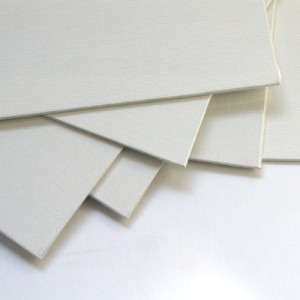Canvas Type
Posted by admin | Under canvas Sunday Apr 25, 2010 There is almost no limit to the kinds of surface on which you can paint in oil. As with no other medium, the entire canvas is usually covered with paint, and the only part that is left showing is the weave of the fabric. Even that is becoming less true, with the growing use of ever thicker layers of pigment.
There is almost no limit to the kinds of surface on which you can paint in oil. As with no other medium, the entire canvas is usually covered with paint, and the only part that is left showing is the weave of the fabric. Even that is becoming less true, with the growing use of ever thicker layers of pigment.
Although I prefer to carry prepared canvas boards because they are light and don’t need elaborate preparation or stretching, there is a multitude of other possibilities. You can use hardboard panels, plywood or metal. All of these need to be rubbed down with sandpaper before you start work, to give the paint something to key into. This roughness is called ‘tooth’.
Canvas can be bought in rolls or, more expensively, already attached to stretchers. The rule for the sort to choose is logical and easy to understand: rough for large pictures, where you will be splashing on the pigment with a certain abandon; fine-grained for small pictures, that will be worked on in thin washes and covered in fine detail.
Cotton or duck canvas is bright white, cheap and easy to stretch. Jute canvas is much stronger, darker in color and far more expensive.
Whatever surface you choose, keep away from synthetic fabrics unless they have been especially prepared for oil painting. Otherwise, the oil may dissolve the fabric, and you could find yourself with tiny holes in your most successful picture.
Canvas boards are sold by most art shops in a wide variety of sizes. They are backed onto a kind of heavy cardboard; they are not too expensive, and provide a clean, white surface in a reasonable range of medium-rough to smooth textures. They are ideal for outdoor painters since several can be carried tied together with string. A finished board can be easily taken home, carried in your hand if necessary.
If you are using acrylics, you can also use paper; there are pads designed for use only with these paints. If you prefer to work on canvas or canvas boards, it is essential that these have been prepared for acrylics, not oils. And avoid re-using canvas that has already been painted with oils – the acrylic film will not adhere properly.
